Southeast Asia: Malaysia, it's worth a trip!

View Larger Map
Before I start to describe the rivers, I will give you some leads for your equipment. You do not need a paddle top, but a good long sleeve rash top. We used the L6 Mercury: long sleeve rash top with a UPF 50 sun protection, which is important in tropical areas. In many areas you will find leechers. They are not dangerous but annoying. So a good tip is to wear a long rash pants or leggings under your shorts. It is good to have a fast drying shorts like the L6 X-Pansion shorts. Good shoes are recommend too, you need to be attuned to walk through thick jungle with snakes and insects of all kinds. However, most important is drinking water. The rivers are not of drinking quality, so either you take drinking water with you or a water filter (i.e. MSR MiniWorks EX microfilter). I recommend you to put the water filter into your boat and always take it with you. The same is true for your FindMeSpot.
Slim river // Kayaker: Benjamin Nolden
Slim River
(next town: Ulu Slim)
Put-in: 3°57'37.52"N ; 101°30'16.53"E ; the road there turns after a small village into a mud road. A 4WD and a clearance height of at least 20cm (7⅞ inches) is advisable. When it rained you need a very coarse tyre pattern. We left our car at the beginning of the mud road and asked a farmer to shuttle us with his tractor. It was for free. The put-in is at a small holiday village. Put-out: 3°56'18.90"N ; 101°30'41.57"E ; in a small village right before the mud road begins. You need to walk through the backyards to get from the river to the road. Be aware of the dogs ;-) Description: First of all: for this river the gauge cannot be high enough. We ran it twice, the first time with a "brown" flow after heavy rainfall and the second time at a usual flow. The high water run was definitely the better one. The Slim river is a good starter for Malaysia, to become more confident at tropical whitewater and temperatures. Mostly it is straight forward class III whitewater, with just a few eddies. There was only one class IV rapid, the "broken nose" as it is named by the locals. The river divides into two channels, both runnable. We prefered the right channel with a small drop into a cushion. Especially at a high flow it is super smooth to go. From here to the put-out there is awesome tropical class III(+) whitewater.
 Slim river at normal flow. // Kayaker Flo Hafner
Slim river at normal flow. // Kayaker Flo Hafner Slim river at a juicy flow // Kayaker: Max Eberl
Slim river at a juicy flow // Kayaker: Max Eberl
Chamang section on Perang River
(also called: Sungai Perting; next town: Bentong)
Put-in: 3°30'33.62"N; 101°51'29.80"E ; the road ends at the famous Chamang falls parking lot. This is the put-in. Put-out: 3°30'33.08"N; 101°52'31.93"E ; the put-out is at a gravel or sand plant. The way down to the plant is not so obvious, so keep your eyes opened. Some Pakistani run the plant, their boss has a motorbike and will give you a shuttle ride for 3-5 ringgit (≈$1). Description: Right below the amazing cascades of the Chamang you will start your journey through the jungle. The section is a good option for a quick evening run and only takes less than an hour. As all rivers in the rainforest the difficulties strongly depend on the level. At a normal low flow it is just a class III river. The jungle becomes thicker with every kilometer you paddle. At the beginning of the last third of this section there is an nice slide into nasty hole (see the pictures). When the jungle opens and you will see the cables from the digger of the sand mine. The exit on the left bank.
Upper Batang Kali
 Benjamin Nolden on the first drop of the Upper Batang Kali. // Photo: Max Eberl
Benjamin Nolden on the first drop of the Upper Batang Kali. // Photo: Max Eberl
Put-in: 3°25'36.12"N; 101°44'1.86"E you need to park your car at the road and then use the trail through the thick jungle down to the river. Put-out: 3°25'45.29"N; 101°43'44.09"E at the forest reserve parking lot. Description: The Batang Kali has a upper (1KM) and a lower section. CK, our friend from Malaysia, told us "there is a first descent in the upper gorge" and "you could be the first ones going the lower gorge". So we were fired up to charge this steep creek. First of all, you need much water to run this creek. We had a "pretty good level" as CK said, but a few inches/centimeters more are better. The river is a more or less steep creek with low volume. Its highlights are two drops, which are both good to go. The first drop has a tricky entrance, which needs more water to run it. But the main drop is absolutely smooth to go.
 Czkiam Ng on the Upper Batang Kalis' first drop. // Photo: Max Eberl
Czkiam Ng on the Upper Batang Kalis' first drop. // Photo: Max Eberl Max Eberl stomping the first drop. // Photo: Benjamin Nolden
Max Eberl stomping the first drop. // Photo: Benjamin NoldenAfter some bends through medium remote but thick jungle you will come to the second drop which was a first descent. When we saw it, we were surprised noone did this drop before. After a short Roshambo lucky Benny was the first to go. Keep your eyes open, there is a rock at the bottom of the drop and you need to land somewhere river right of this rock. Then CK and I followed. CK hit the rock but luckily nothing happened, no crack in his boat, no injuries. Overall the Batang Kali is a nice class III river with maybe two class IV- rapids.
 2nd drop // Kayaker: Benjamin Nolden // Photo: Max Eberl
2nd drop // Kayaker: Benjamin Nolden // Photo: Max Eberl 2nd drop // Kayaker: Max Eberl // Photo: Benjamin Nolden
2nd drop // Kayaker: Max Eberl // Photo: Benjamin NoldenLower Batang Kali
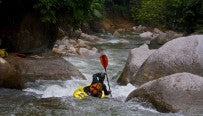 Benjamin Nolden on the Lower Batang Kali. // Photo: Max Eberl
Benjamin Nolden on the Lower Batang Kali. // Photo: Max Eberl
Put-in: 3°25'45.29"N; 101°43'44.09"E at the forest reserve parking lot. Put-out: 3°26'26.61"N; 101°41'59.25"E Description: First of all, make sure you do not put-in to Sungai Kedondong, which is a tributary to the Batang Kali. It has several steep and unrunnable sections due to a too low flow. The Batang Kali quickly starts with a small gorge. You can scout all rapids, some are only runnable at high flows. When the gorge opens and the Sungai Kedondong joins, you can expect some nice class III whitewater.
Sungai Sungkai (Upper Section)
Put-in: 4° 6'55.01"N; 101°27'8.28"E Park your car in the village, ask for permission. Put-out (option 1): 4° 1'58.03"N; 101°24'31.31"E Put-out (option 2): 4° 0'3.84"N; 101°23'31.56"E Orientation mark: Steel bridge afer 1/3 of the section. 4° 3'48.90"N; 101°25'30.01"E
Description: The Sungkai river was one of the longest sections we paddled. It is something between 15 and 17 Kilometers. Usually you need the whole day for this river. The road to the put-in is not in a good shape, i.e. you need a 4WD to get there. The other part of the story is the shuttle. If you take put-out option two you need to shuttle 30 kilometers, half of them on a dirt road. How about the river? The Sungkai is a fairly remote river. It offers some tropical class III-IV whitewater in a thick jungle scenery.
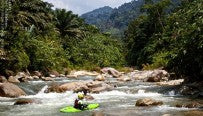 Tropical whitewater // Kayaker: Flo Hafner // Photo: Max Eberl
Tropical whitewater // Kayaker: Flo Hafner // Photo: Max Eberl Benjamin with the Sungkai Kids // Photo: Max Eberl
Benjamin with the Sungkai Kids // Photo: Max Eberl Cool boy at Sungkai // Photo: Max Eberl
Cool boy at Sungkai // Photo: Max Eberl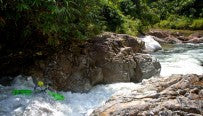 Sungkai, the first little drop. // Kayaker: Flo Hafner // Photo: Max Eberl
Sungkai, the first little drop. // Kayaker: Flo Hafner // Photo: Max Eberl The micro gorge. // Kayaker: Max Eberl // Photo: Benjamin Nolden
The micro gorge. // Kayaker: Max Eberl // Photo: Benjamin Nolden Entrance of the cataract // Kayaker: Max Eberl // Photo: Benjamin Nolden
Entrance of the cataract // Kayaker: Max Eberl // Photo: Benjamin Nolden Sticky hole at the end // Kayaker: Max Eberl // Photo: Benjamin Nolden
Sticky hole at the end // Kayaker: Max Eberl // Photo: Benjamin NoldenSungai Woh
 Bouldergarden at the beginning // Kayaker: Max Eberl // Photo: Benjamin Nolden
Bouldergarden at the beginning // Kayaker: Max Eberl // Photo: Benjamin Nolden
(next village: Kampung Woh or Kampung Batu Enam; T-intersection to access road: 4°14'57.36"N, 101°19'7.81"E)
Put-in: 4°12'48.51"N; 101°22'33.81"E; the road ends at a parking lot next to a weir and an abandoned house. Follow the small trail behind the house and cross the small Orang-Asli (natives) village, the trail continues. You can walk as far up as you like, we suggest this put-in (see coordinates) because it seems the upper part is not interesting. Put-out: 4°13'23.23"N; 101°20'7.57"E Description: We were the second team that paddled this river, but the first team which made a nearly complete descent (1 portage > wood lock). Let me say, this river is not abnormal difficult but absolutely rad. The scenery is breathtaking and the character different from other rivers in Malaysia. It starts with some boulder garden and when it picks up gradient the bedrock part starts. There are some fun slides and cool places to have a break…so don't forget to pack some food and cans of…whatever.
 Awsome bouldergarden // Kayaker: Benjamin Nolden // Photo: Max Eberl
Awsome bouldergarden // Kayaker: Benjamin Nolden // Photo: Max Eberl Fine bedrock // Kayaker: Max Eberl // Photo: Benjamin Nolden
Fine bedrock // Kayaker: Max Eberl // Photo: Benjamin NoldenAnyhow, there is one longer cataract which is also the most difficult rapid. It starts with some small holes followed by a 2.5m/9ft. You jump into a small pool that you exit by a small drop. This drop goes into a diagonal hole which charges a bigger and sticky hole followed by a third hole with a siphon on the left. Looks not too good but it is really good to go.
 Entrance drop of the key rapid // Kayaker: Benjamin Noldne // Photo: Max Eberl
Entrance drop of the key rapid // Kayaker: Benjamin Noldne // Photo: Max Eberl Key rapid exit // Kayaker: Max Eberl // Photo: Benjamin Nolden
Key rapid exit // Kayaker: Max Eberl // Photo: Benjamin NoldenSungai Singor
(next town: Gerik)
Lower section: Put-in: 5°30'28.93"N ; 101°30'59.38"E ; see below for a detailed description Put-out: 5°31'19.91"N ; 101°28'37.10"E ; at the bridge/ranger station Description: The Singor is THE destination in Malaysia for kayaking - it is absolutely remote and offers finest class III-V whitewater, strongly depending on the water level. Two days before we planned to run the Singor, I broke one of my ribs. Nevertheless we headed to the Sungai Singor and decided to paddle the lower section first to check my physical constitution. The lower section is a single day trip of 4-6 hours paddling and 2-3 hours drive in/out. You need a 4WD to get to the put-in and a real good 4WD (Isuzu D-Max, Toyota Hillux etc.) when there is rainy weather (forecasted). Otherwise you may stuck deep in the jungle with little chance to get out there the same day. There are so many logging roads that it is hard to find the right way to the put-in. So let me give some good leads how to get there: Coming from Gerik follow the highway 4. You will cross the Banding Lake, make a stop and have a meal. You can get there a local delicacy, fish which is cooked in a palm leave with coconut milk…yummy yummy. Continue driving eastwards on the highway 4. When you leave the bridge over the lake (5°33'1.50"N; 101°21'8.77"E), continue for 10.2KM/6.35mi. Then you will reach the "exit" Air Banun (5°34'7.71"N; 101°25'10.80"E). There is also a small bus stop house. Here you turn right (southwards) and follow the road down in direction of the village Air Banun.
 Exit "Air Banun"
Exit "Air Banun" Our 4WD and some offroad action
Our 4WD and some offroad actionShortly before you reach the village turn right onto a logging road (5°33'37.47"N; 101°24'47.60"E). After 75m/ 245ft turn left at a T-intersection. Follow this road for 14.9KM/9.27mi. Somewhere in between you will cross a huge timber collection area, try to stay parallel to the river and do not take the curve to the North ;-) When you completed the 14.9KM/9.27mi turn right (5°31'28.49"N; 101°28'36.21"E), after 250m/820ft you will reach a bridge with a small ranger station on the river right, this is the put-out (5°31'19.91"N ; 101°28'37.10"E).
 Put-out bridge from river right downstream
Put-out bridge from river right downstream POS Ranger station. The train to the Singor starts at the porch.
POS Ranger station. The train to the Singor starts at the porch.Go over the bridge and continue driving for 3.58KM/2.22mi. At the fork take the left road downhill (5°30'46.32"N; 101°29'32.53"E). From this fork go on for 4.57KM/2.84mi and you will reach a logging camp (put-in: 5°30'28.93"N ; 101°30'59.38"E). From here you need to follow a small trail down to the river (10min). Not too complicated…
Typically on the Sg. Singor rapids are followed by flat sections. Directly at the put-in there is the first cataract, numerous rapids following. Too many to explain each in detail. We had a low flow, every rapid could be portaged. Even at higher flows it should be possible to scout and portage.
 Entrance to the first cataract on lower Sg. Singor
Entrance to the first cataract on lower Sg. Singor Max Eberl in a drop of the first cataract.
Max Eberl in a drop of the first cataract.At normal flows the difficulties does not exceed class IV. But you need to remember that you are in a tropical area, locals reported that the level can rise easily by a meter/3.5ft within a couple of minutes. That is a lot, especially in a remote area. The most difficult rapid was a drop with a huge backwash followed by two holes.
 Little double drop on Sungai Singor.
Little double drop on Sungai Singor. Drop on Sungai Singor.
Drop on Sungai Singor.After this little double drop the Sg. Singor opens up and constantly becomes easier. But there still some fun rapids to enjoy.
 Ben enjoying one of numerous rapids.
Ben enjoying one of numerous rapids. Flat section at the end.
Flat section at the end.Upper section: Put-in: 5°35'50.20"N; 101°38'1.19"E ; follow the logging road from the highway.
Description: We did not paddle the upper section due to my broken rip from Sungai Woh. But there is some general information about the upper section we would like to share. The river you put-in is not the Sungai Singor, it is the Sungai Mangga. Usually you combine the upper section with the lower section, it takes 3 days to paddle the complete stretch. The first camp is at the confluence of Sungai Mangga into the Sungai Singor (approx. 5°32'2.96"N; 101°32'53.74"E). The second camp is at the put-in of the lower section.
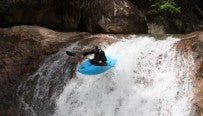 Ben at one of the drops at Jerangkang.
Ben at one of the drops at Jerangkang.
Jerangkang Slides
Park and huck: 3°46'9.71"N; 102°56'3.56"E Description: To get to the put-in you either need a 4WD or a driver with a 4WD. When the road is absolutely dry you can also to there by 2WD. Be aware of fast logging trucks which do not brake for you. The right way it is not too easy to find. To get a good description ask in the restaurant next to the mosque (3°41'56.85"N; 102°59'7.25"E). The owner will also drive you there. His cell is +60199682210. The Jerangkang consists of a couple of drops and slides. It is hard to catch it at a good level. Usually it runs after it heavy rains. A good option is to go there in at the afternoon and sleep at the waterfalls…waiting for rain. In the rainy season it usually rains around 5-6 p.m.
I hope you enjoyed this guide. Do not hesitate to write me on Facebook if there are questions.






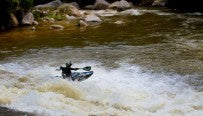 Slide on Chamang (Perang river) // Photo: Benjamin Nolden / Kayaker: Max Eberl
Slide on Chamang (Perang river) // Photo: Benjamin Nolden / Kayaker: Max Eberl